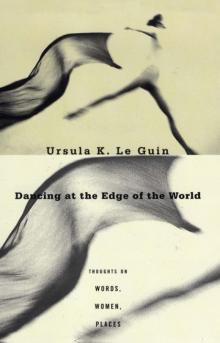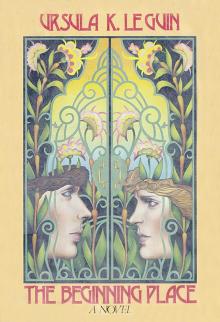- Home
- Ursula K. Le Guin
Words Are My Matter Page 7
Words Are My Matter Read online
Page 7
Aside from that, I can’t remember anything out of proportion or uncomfortable or unfriendly about that house. It could be terrifying at night, but I will get to that later. Even in daylight it was shadowy in places, like a forest. Maybeck speaks somewhere in his writings of “dark heights,” and our house had such dark heights. It was built entirely of redwood inside and out, and redwood darkens with age, but it was full of tall windows and glass-paned doors.
Because the walls and ceilings and spaces were so interesting in themselves, it seemed to require little furnishing. When I was a child we had no rugs downstairs, just the wide bare floors, and most of our furniture was shabby: odd chairs, wicker stools, a horsehair and mahogany sofa that was easier to slide off than to sit on, my mother’s mother’s bed with the bullet embedded in the footboard, and so on. The dining table was one of our few elegant pieces, because it had been built with and for the house—a single broad redwood board, rather low as tables go, that sat eight comfortably and ten with a squeeze. It was somewhat battered, since redwood is soft and scars easily, but if you beeswaxed it diligently, it got a fine, deep glow, like a chestnut horse. There were cabinets built in corners here and there, in good Arts and Crafts style, some with paned glass fronts; and a seat like a window seat ran along the inner living-room wall, at right angles to the huge firebrick hearth and chimney. That was comfortable. So were the little stone seats built out from the hearth, where you could sit almost inside the fireplace and get really warm.
Except in the few, always threatened groves protected for tourists, there are no sequoias left like those from which that dining-room table was cut, or with which the whole house with its great rafters and wide, long, clear boards was built. Sequoia sempervirens were common in many northern parts of California, and their wood was as commonly used for building houses. It was cheap then, and it has remarkable virtues as lumber, resistance to dry rot and weather among them. Our house in the Napa Valley, a humble ordinary farmhouse of the 1870s, was built of redwood—painted and papered as if it were mere pine or fir. Maybeck’s generation realised the extraordinary beauty of the wood, and used it bare and grand. What they didn’t realise was the exhaustibility of the sequoias. I don’t think anyone thought much about that in 1907. None of us thought much about it till the fifties. Then, as the price of redwood went up and up, and the Save the Redwoods people fought their endless struggle against the lumber companies and the politicians, we began to look up at those wide, sweet boards and beams with a guilty, grateful awe.
They were untreated, but sanded to a silken finish. Cardwell describes the color of a natural redwood interior very well: “The pink tone of new lumber mellows rapidly to a rich red-brown which is highlighted by an iridescent gold caused by the refraction of natural or incandescent light falling on the spring wood of the boards.”
The house was not only built throughout of redwood but had several Sequoia sempervirens planted just northwest of it; they were very large and grand by the time I first remember them. The west front stood high above the street over a steep slope and a double flight of stone-walled steps. The whole exterior was in the general style of a mountain chalet, with peaked roofs, deep eaves, and wooden balconies jutting out on all four sides and from both stories. The beams and struts supporting the eaves and balconies made bold diagonals against the sky and against the batten walls—the lower story with horizontal battens, the upper with vertical. This sounds ornate in words, but the simplicity of the dark wood and the massive, splendid proportions of the house itself subordinated all its roof angles and balconies to the tall, rather stern and noble whole. Decorative elements, like that tiny north balcony, kept the nobility from being either boring or overwhelming. The house both soared up from its commanding position at the top of a hill-street and echoed the slope of the hills as a whole in the long western downsweep of the main roof. In every aspect it was superbly suited and fitted to its landscape and community.
It became, with the years, ever more suited and fitted to its occupants.
One of the bedroom balconies, intended as a sleeping porch, was roofed and enclosed with windows to make a sunny, narrow playroom for the four children of my family; I don’t know whether the Schneiders or we did that. We did a lot of things to that house. It was built for a family with only one child—Cardwell calls it “a modest house constructed on a modest budget.” There were seven of us in it by 1930, and we must have been pretty crowded until my father added a wing to the east side: four rooms, two baths, two fireplaces, and a spacious attic. (The attic of the original house was a dreadful dark crawlspace, unusable except by black widows and bats.)
Nobody, I suppose, would dream of building on to a Maybeck house these days; the Great Man syndrome tells us that the Master’s work is sacrosanct. I can only say that the wing designed by my father and his carpenter-builder, a Welshman named John Williams, fits seamlessly onto the house; no visitor I ever took round realised it wasn’t part of Maybeck’s original design. In proportions, the size and shape of windows, and so on, it matches the original, though without deep eaves or balconies, and without the fine details of iron latches, etc., in the William Morris style, which would have been out of fashion in the thirties and hard to find. This large addition perfected the comfortableness of the house for us, perhaps for the children most of all—lots of rooms, corridors to race through, space to crowd into, space to be alone in, sunny corners, an enormous attic where we set up the electric train and the armies of toy soldiers.
My mother always said that women didn’t like that house and men did. I think this was one of my mother’s theories. The house did have a hunting-lodge quality, a certain rough, roomy starkness, which might be seen as having a virile appeal to men and not to chintz-loving women; but then, we didn’t know many chintz-loving women. The women and girls I knew who knew the house loved it.
The kitchen, perhaps, wasn’t the modern housewife’s ideal—not many kitchens built in 1907 were. It was rather narrow, but there is convenience in being able to turn from the stove to the chopping board to the sink to the fridge in a few steps. It did have the one element that to me is essential in a kitchen, that is, a window over the sink. The window looked out into the north garden and the boughs of a crab-apple that blossomed wonderfully in spring. There were plenty of good kitchen cabinets and drawers, and a wall of shelves to keep and display china, with sliding wood-framed glassed doors from waist level up to the ceiling. Those tall doors were well made, like everything belonging to the house; they continued to slide admirably all the decades we lived there. The pantry, off the narrow hall at the foot of the back stairs, across from the King of Scotland’s door, was the kind with a screened opening to the outside to keep it cool; it was a tiny dark room full of shelves, smelling of apples and old pfeffernusse and other pantry things. I would go into the pantry sometimes just to smell it.
Its smell was partly redwood. The wood is aromatic; you can’t easily catch the scent in a single piece as you can in a piece of cedar or fresh-cut pine, but an enclosed space built of it has a characteristic fragrance, dearly welcome to the nose to which it smells like home. To come into our house after a long absence was to know again how immediately and profoundly the nose is connected to the emotions.
Because it has nothing to do with sight or touch or hearing, the space in which smell takes place seems to me to be dark or at least shadowy; still; and without boundaries, therefore very large: mysterious and benign. In this it resembles the very earliest and most primitive impressions that I find in my memory of the house itself.
I said, above, “the north garden,” which sounds rather grand; and in fact, the original garden must have been grand. The house stood just south of the center line of a double lot, and its steep hillside garden filled both lots. It was laid out by John McLaren, the designer of Golden Gate Park. It had a rose plot and a fountain. It was formal, as the house was not. I do not remember this garden. I can just remember some flower beds and the fountain, which didn’t fo
unt, but dripped a little. The redwoods and the ground juniper and a pair of English yews in front of the house, a fine camphor tree south of it, a big abelia, and a couple of very William-Morris weeping willows were elements of it that remained through my childhood. I don’t know whether the Schneiders kept the garden up or let it go; we certainly let it go. Part of it became a badminton court, and the rest of it straggled along the way gardens of large families tend to do. I laid out acreage for my Britains toy farm set between the old roses, and played in the secret passages under the huge cumquat bushes, until my parents decided to build two houses on the north lot as rental properties. The crab-apple tree remained in its glory, and both new houses had crowded, flowery little gardens, so our view while washing the dishes remained charming. The garden of our house was thus reduced to manageable size; and as we children grew up, my parents had time to potter in it, and my father planted and tended roses and dahlias, which he loved.
I realise I may be causing real pain in describing the desecration of a unique Maybeck chalet and McLaren garden by an uncouth anthropologist, a Welsh carpenter, and a swarm of brats. I am sorry if this is so. It seems to me that we used both the house and the garden the best way we could. We used every inch of the house. We adapted ourselves to it and it to ourselves. We lived in it intensely and completely. We adored it and abused it as children do their mother. It was our house and we were its family. I think this is exactly what Maybeck had in mind when he built it. I hope so. He lived farther up the hill, in one of his chicken-wire houses. I have a faint recollection of a visit from him; I must have been very small, because I remember looking up at the gentle curve of his belly, and he was a very short man. It seems to me his trousers were fastened differently from other men’s trousers, with a single central button placed somewhere high, but I can’t get the image clear. His presence was mysterious and benign.
I keep talking about comfort, practicality and impracticality, stairs, smells, and so on, when what I want to talk about is beauty; but I don’t know how to. It seems you can only describe beauty by describing something else, the way you can only see the earliest star after sunset by not looking directly at it.
Surely, if you have lived in one house from birth to maturity, you’re going to find the house entangled with your psyche. This may depend somewhat on gender; women are said to identify themselves more with their house, or their house with themselves, than most men do. The old ranch house in the Napa Valley was and is extremely dear to me, as is the house in Portland I have lived in for nearly fifty years now. But the Berkeley house was fundamental. If I recall my childhood, I recall that house. It is where everything happened. It is where I happened.
And the space it allowed me to happen in was truly extraordinary—that is what I am trying to talk about. It was unusually beautiful. Not just pretty and pleasant: much more than that. Maybeck’s artistic standard was very high. Everything around us indoors, under the scurf and scruff of children’s stuff and the mess of daily living, every surface and area, was nobly proportioned, handsome and generous in material and workmanship, grave, genial, and spacious.
Cardwell says of the house, “Its ample feeling was developed by Maybeck’s skill in relating one volume to another, as well as by his astute placement of voids in the walls that define them.” The finest of those voids, I think, was created by the single massive redwood-cased pillar that supported the massive main beam of the living-room ceiling; you met it as you came from the rather dark entry hall into the large light living room, sunlit all afternoon. You were aware of the empty spaces around that pillar. You were aware of the movement of the air around it (indeed, the house was rather drafty, but in California that doesn’t much matter). You were aware of the clear, firm intention of the pillar itself. The house depends on me, it said, and I am dependable.
The many windows and the several sets of French doors admitted the extraordinary light of the Bay Area, which combines inland sunshine with sea-reflected radiance. Each window had a view, either of pleasant Berkeley gardens or, to south and west, the magnificent sweep of San Francisco Bay and its cities and bridges. Each window in itself was a pleasure, low-silled, but always tall enough to include the sky.
A house so carefully and deliberately planned and intended to give pleasure has got to have an influence on a person living in it, and perhaps most of all on a child, because for a little child the house is pretty much the world. If that world has been deliberately made beautiful, a familiarity with and expectation of beauty, on the human scale and in human terms, may develop in the child. As Maybeck said, such daily experience “will have the same power over the mind as music or poetry.” But the experience of music or poetry is brief, occasional. To a child living in it, the experience of the presence of a house is permanent and inclusive.
I fear I may seem to be describing a little princess growing up in a palace. That’s not it. A palace may be beautiful or may not. Beauty’s not its business. The business of a palace is to express power, wealth, importance. The modern McMansion is far more palatial in that sense than any Maybeck. When Maybeck built a palace, it wasn’t for kings and princesses to live in or as a statement of grandeur and wealth, it was to house and celebrate the public art display of a popular exposition. His buildings declare power only in the integrity and honesty of their design. The only purpose the Maybeck house might be said to share with a palace is the expression of order.
When the relationship of everything in the structure around you is harmonious, when the relationships are vigorous, peaceful, and orderly, one may be led to believe that there is order in the world, and that human beings can attain it.
What I am circling around here is the very difficult question of the expression of moral feeling, and the advancement of moral feeling, through aesthetic means.
Just growing up in a beautiful environment is not going to shape a child’s mind favorably. The human, social factor outweighs nature decisively. The extraordinary natural splendor of the Bay Area is probably not a very large factor in the development of kids growing up in poverty in the Oakland slums, though it may offer them some relief from decay and disorder. Even apart from social degradation and industrial ugliness, people who live way out in the country among lovely, varied scenery don’t seem to have more breadth of soul or nobility of purpose than those who never saw anything in their life but dreary scrubland. For the beauty of nature as such to brighten and enlarge the mind, I think a child needs either an unusual gift of observation, or a gradual training in observation and aesthetic perception, that will deepen with maturity.
There is evidence that young children kept in a single room or a narrow apartment arrive at school with stunted intellectual, spatial, and social skills, mentally handicapped by the physical and visual limitations of the space they grew in. It is hard to doubt that the cramped, ugly, filthy, noisy, disorganised surroundings of slums and poor barrios foster depression and anger in children who live in them, and limit and darken their perception of the world as a whole. All the same, their awareness of human interdependence and mutual responsibility may be far more intense than that of the middle-class child brought up with a room of her own.
Neither natural beauty nor deliberately created beauty is enough to foster moral perception and discrimination. But I think it possible that early and continuous experience of aesthetic beauty may foster an expectation of order and harmony that may in turn lead to an active desire for moral clarity. I have trouble distinguishing the ethical from the aesthetic. Both my ethical and my aesthetic responses tend to be immediate to the point of suddenness; hesitant only in cases of real novelty or complexity; and stubborn, though capable of being educated and improved. They are so much alike that I am often uncertain whether I’m responding ethically or aesthetically. “That’s right: that’s wrong.” Such spontaneous certainty seems shallow, but it is not: it is deep and deeply irrational, rising from old, tangled, multitudinous roots, reaching down to the depths of me. As soon as I try to justify
it, to find its reason, I’m in deep. When I ask myself why I think the Gehry museum in Seattle is wrong and why I think the Palace of Fine Arts in San Francisco is right, I am involved in the same immensely laborious, ultimately unsatisfactory processes as in explaining why I think abortion on demand is right or why I think torture is wrong. And I do not feel a real difference in kind—or even of importance—between the ethical and the aesthetic inquiry. But to pursue that statement further would require some understanding of philosophy, and I have none.
I will not pursue abortion, torture, or Gehry either, but will come back to the house I lived in. I think the house was built to an aesthetic ideal or concept which was indistinguishable from—or which I cannot distinguish from—a moral ideal or concept. Is it not fair to say that every building has a morality, in this sense, and not merely a metaphorical one, in the honesty and integrity of its design and materials, or the dishonesty expressed in incompetence, incoherence, shoddiness, fakery, snobbery?
I think I absorbed this morality of the building as I did the smell of redwood or the sense of complex space.
I think the moral conception of the building was as admirable as its aesthetic conception, from which it is, to me, inseparable.

 Catwings
Catwings Tehanu
Tehanu The Tombs of Atuan
The Tombs of Atuan A Wizard of Earthsea
A Wizard of Earthsea The Other Wind
The Other Wind Ursula K. Le Guin
Ursula K. Le Guin Dangerous People
Dangerous People Worlds of Exile and Illusion: Rocannon's World, Planet of Exile, City of Illusions
Worlds of Exile and Illusion: Rocannon's World, Planet of Exile, City of Illusions Three Hainish Novels
Three Hainish Novels The Left Hand Of Darkness (SF Masterworks)
The Left Hand Of Darkness (SF Masterworks) The Unreal and the Real - Vol 1 - Where On Earth
The Unreal and the Real - Vol 1 - Where On Earth The Visionary
The Visionary The Ones Who Walk Away from Omelas
The Ones Who Walk Away from Omelas The Word for World is Forest
The Word for World is Forest Always Coming Home
Always Coming Home The Unreal and the Real - Vol 2 - Outer Space, Inner Lands
The Unreal and the Real - Vol 2 - Outer Space, Inner Lands Malafrena
Malafrena The Lathe of Heaven
The Lathe of Heaven Five Ways to Forgiveness
Five Ways to Forgiveness The Eye of the Heron
The Eye of the Heron Four Ways to Forgiveness
Four Ways to Forgiveness Powers
Powers Dancing at the Edge of the World
Dancing at the Edge of the World Very Far Away from Anywhere Else
Very Far Away from Anywhere Else Voices aotws-2
Voices aotws-2 The New Atlantis
The New Atlantis The Unreal and the Real, Selected Stories of Ursula K. Le Guin Volume 1: Where on Earth
The Unreal and the Real, Selected Stories of Ursula K. Le Guin Volume 1: Where on Earth The Telling
The Telling Tehanu (Earthsea Cycle)
Tehanu (Earthsea Cycle) Nine Lives twtq-9
Nine Lives twtq-9 The Birthday of the World and Other Stories
The Birthday of the World and Other Stories The Dispossessed
The Dispossessed Changing Planes
Changing Planes Words Are My Matter
Words Are My Matter Powers aotws-3
Powers aotws-3 Lavinia
Lavinia The Wind's Twelve Quarters
The Wind's Twelve Quarters Orsinian Tales
Orsinian Tales Gifts aotws-1
Gifts aotws-1 Coming of Age in Karhide
Coming of Age in Karhide The Books of Earthsea: The Complete Illustrated Edition
The Books of Earthsea: The Complete Illustrated Edition The Found and the Lost
The Found and the Lost No Time to Spare
No Time to Spare Voices
Voices The Wild Girls
The Wild Girls Old Music and the Slave Women
Old Music and the Slave Women The Daughter of Odren
The Daughter of Odren A Fisherman of the Inland Sea: Stories
A Fisherman of the Inland Sea: Stories A Wizard of Earthsea (The Earthsea Cycle)
A Wizard of Earthsea (The Earthsea Cycle) The Beginning Place
The Beginning Place The Left Hand of Darkness
The Left Hand of Darkness The Farthest Shore (Earthsea Cycle)
The Farthest Shore (Earthsea Cycle) The Matter of Seggri botw-2
The Matter of Seggri botw-2